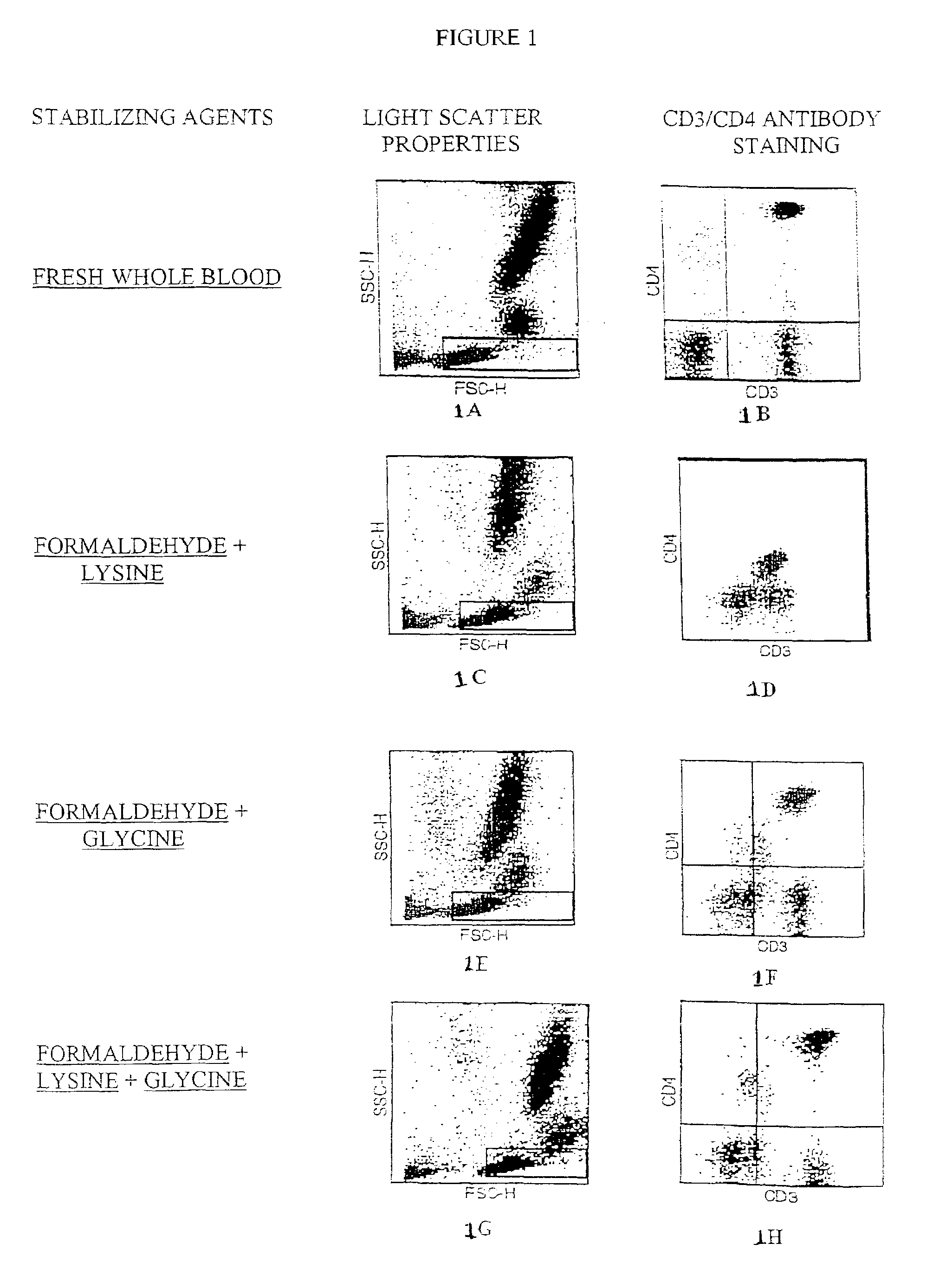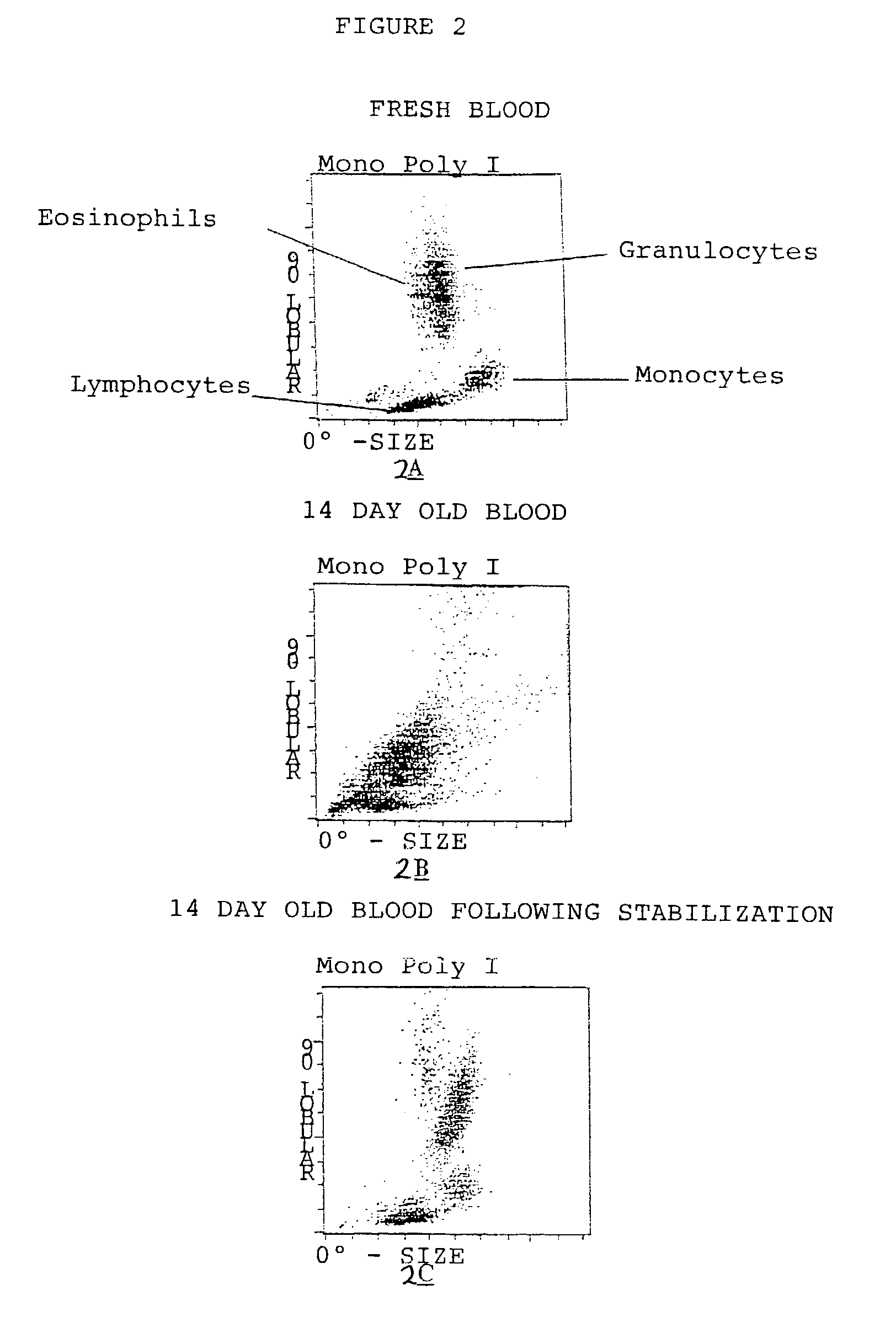Stabilizing solution for cells and tissues
a technology of stabilizing solution and cells, applied in the field of formulations, can solve the problems of significant drawbacks and inability to analyze specimens immediately, and achieve the effect of low non-specific staining properties and good specific staining properties
- Summary
- Abstract
- Description
- Claims
- Application Information
AI Technical Summary
Benefits of technology
Problems solved by technology
Method used
Image
Examples
example 1
Stabilization of Fresh Blood
[0036]Human blood was collected and fractionated by aphoresis. Leucopacks enriched for WBCs were further concentrated by centrifugation, with removal of the bulk of RBCs, platelets and plasma. Cells were washed, with phosphate buffered saline, containing 0.1% azide.
[0037]The cells were incubated in a stabilizing solution which included 0.2 moles of lysine per mole of formaldehyde and 0.3 moles of glycine per mole of formaldehyde, pH 7.4, and other additives from the following commercial suppliers:
Materials:
Formaldehyde, 37% w / v (Sigma / Part # F-1635
Procaine Hydrochloride (Sigma / Part # P-9879)
ADA / N-(2-Acetamido)2-Iminodiocetic Acid (Sigma / Part # A-9883)
Pyrithione / 2-Mercaptopyridine-N-Oxide, sodium salt, 40% (Avocado / Part # A16922)
Sodium Hydroxide (Fluka / Part # 71691)
Sodium Sulfate (Sigma / Part #S-9627)
Sodium Chloride (Sigma / Part #S-9625)
Lysine (Sigma / Part #L-5626)
Glycine (Sigma / Part #G-7126)
[0038]The total cell count was determined on a standard hematology a...
example 2
Demonstration of Use of Stabilizing Solution to Obtain Stabilization of Human WBCs and RBCs Suitable for Flow Cytometric Analysis
[0042]WBCs were collected by aphoresis and then stabilized by exposure to stabilizing solutions containing the following stabilizing formulations: 15 mM formaldehyde plus 3 mM lysine or 15 mM formaldehyde plus 4 mM glycine or 15 mM formaldehyde plus 3 mM lysine plus 4 mM glycine. Cells were stabilized for 4 days in the stabilizing solution and then blended with human RBCs also stabilized in the same manner. The final product was resupended in phosphate buffered saline supplemented with 3% BSA, 3% sugars and antimicrobials. These stabilized controls (FIGS. 1D, 1F, 1H) were processed for antibody staining for two CD markers, CD3-Fluorescein and CD4-Phycoerythrin, and RBCs lysis in parallel with a fresh whole blood sample (FIG. 1B) using commercial reagents obtained from BD Bioscience. These data clearly show that the formaldehyde, lysine and glycine mixture...
example 3
Demonstration of Use of Human Whole Blood Stabilized with the Stabilizing Solution on a Hematology Instrument for Differential WBCs Analysis
[0043]In FIG. 2A we show a CellDyn-4000 hematology instrument analysis of a fresh whole blood sample. Note that four WBC populations are easily identified by this instrument on this display. In FIG. 2B we show the same instrument analysis on the same blood sample after it has aged for 14 days (without stabilization). Note that the instrument was unable to distinguish the same four WBC populations as above (compare FIG. 2B to FIG. 2A). FIG. 2C provides evidence that blood collected in an EDTA tube and stabilized with 0.5 mL of stabilizing solution containing 0.5 M formaldehyde plus 0.1 M lysine plus 0.1 M glycine stabilized the blood sample and allowed it to be processed accurately by the hematology analyzer. Note that whole blood cells stabilized as described in the invention retained the necessary properties to allow the instrument to accuratel...
PUM
| Property | Measurement | Unit |
|---|---|---|
| Fraction | aaaaa | aaaaa |
| Fraction | aaaaa | aaaaa |
| Fraction | aaaaa | aaaaa |
Abstract
Description
Claims
Application Information
 Login to View More
Login to View More - R&D
- Intellectual Property
- Life Sciences
- Materials
- Tech Scout
- Unparalleled Data Quality
- Higher Quality Content
- 60% Fewer Hallucinations
Browse by: Latest US Patents, China's latest patents, Technical Efficacy Thesaurus, Application Domain, Technology Topic, Popular Technical Reports.
© 2025 PatSnap. All rights reserved.Legal|Privacy policy|Modern Slavery Act Transparency Statement|Sitemap|About US| Contact US: help@patsnap.com


